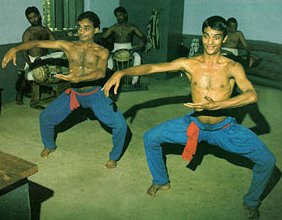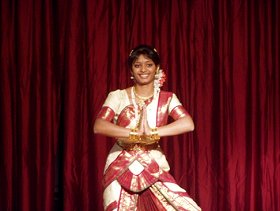
|
 |

|
 |
Becoming and remaining successful in the dance profession - Padma Chebrolu, OH e-mail: padma@culturalcentreofindia.com January 16, 2005 Our Indian classical dance styles have survived centuries of change and uncertainty. But this never ensured making a decent living for dance professionals and these days it has become a constant struggle. In the US, for the past three years due to 9/11, war and unemployment, government funding for arts has started disappearing. Art agencies, schools and organizations are having a very difficult time being operational. With the tragic Tsunami incident, our energies and resources will be focused on helping the surviving victims to overcome their grief and rebuild their lives. In these times of global crisis, how can classical dance professionals continue to be creative, teach, perform and propagate the art form? In a society, where dance and music are in full bloom, we know people there are leading normal lives.  Among dance forms, Indian classical dance styles are the most alluring, intellectual and enjoyable. Presentation of the art form has been matched with the changing life styles of audiences and still maintains the integrity of the art form. But there are many aspects we can consider, like creating higher standards to be one of the world-class dance forms. Dance education Dance graduate programs in India maintain high standards in their technique and theory. But there is hardly any emphasis on training the students on business skills, art administration, networking, dance company internships and grant writing. Unless the students themselves have inborn skills in these areas, they might not financially survive in the real world. Most of the US based dance departments at the universities have a website which clearly explains what programs they offer, how much will be the costs and how to apply for the programs. Many of the India based dance departments do not have a similar setup. So we really do not have an easy way to get foreign students to enroll in the dance departments in India. And for the Indian dance students who could go to other countries to receive higher education in the dance field, they do not have the resources and network. Compared to engineering, computer science and business administration programs in India, dance education seems to be several decades behind. There are few Indian dancers now getting specialized doctorate degrees in dance therapy, art administration, anthropology, dance choreography, art history and so on. This is some good news compared to how far we need to go in opening our doors to foreign students and sending Indian dance students abroad.  Lack of male dance students Many dance studios and schools around the globe are seeing fewer and fewer male dance students every year. A few decades ago, women were not allowed to enter the Indian dance field and now we are seeing parents have become reluctant to send their sons to the dance schools. Indian society is not against men dancing. As you can see in every Indian movie, the hero needs to be a skilled dancer. Classical dance is just not enjoying popularity and appeal among young males. This is a dangerous situation for the future of dance as a profession. Male dance professionals These days we barely see male dancers doing solo performances, arangetrams and receiving special titles/honors. A few male dancers are in the field with their wives, female dance partners or with a dance company. The sabhas, studios and schools need to seriously address the unfair and unequal treatment of male dancers and correct the situation before it is too late.  Traditionalists and new thinkers As a community, we are very quick at criticizing anyone who does things differently. We need to find a balance between scaring dancers to think differently and encouraging them to experiment with innovative ideas. Our dance forms will stagnate if we do not introduce new ideas. As we have audience for the traditional art form, we also have audience for non-traditional, fusion/classical based modern dance form. Our current generation likes to think out side the box and experiment to see how far they can take their creativity. Pure classical dance and music are here to stay and “new thinking” is an evolving and ever changing phenomena.  Double professions Most of us do not have the privilege of making a decent living on just being a dancer. Only a handful of professional dancers have been able to do it so far. As financial security is not very promising in the field of dance, many of us have become double profession(al) dancers. In US, you find many dancers who are physicians, engineers, software professionals, professors, scientists and so on. As dancers, we are creative and spiritual. At the same time, we need to understand the ways of the world and provide high standards in every aspect of dance. We must prepare our dancers with all the skills needed to become and remain successful in their profession. 
Padma is the artistic director of Cultural Centre of India. She is trained in Bharata Natyam, Kuchipudi, Andhra Natyam, and Mohini Attam. Padma extensively writes articles about dance and dance education. Padma works as a software engineer at a major corporation. Contact information at culturalcentreofindia.com |